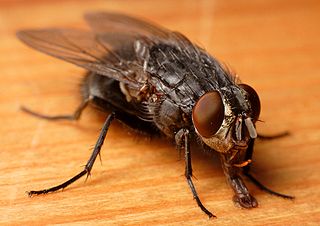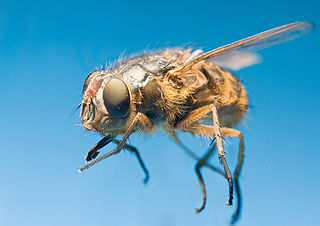
The Calliphoridae are a family of insects in the order Diptera, with almost 1,900 known species. The maggot larvae, often used as fishing bait, are known as gentles. The family is known to be polyphyletic, but much remains disputed regarding proper treatment of the constituent taxa, some of which are occasionally accorded family status.

Cluster flies are flies of the genus Pollenia in the family Polleniidae. Unlike the more familiar blow flies, such as the bluebottle genus Phormia they do not lay eggs in human food. They parasitise earthworms; the females lay their eggs near earthworm burrows, and the larvae then feed on the worms. But the biology of this group is relatively poorly known and a few have been recorded from other hosts including caterpillars and bees.

Calliphora is a genus of blow flies, also known as bottle flies, found in most parts of the world, with the highest diversity in Australia. The most widespread species in North America area Calliphora livida, C. vicina, and C. vomitoria.

Stomorhina is a genus of flies in the family Rhiniidae.

Sarcophaga is a genus of true flies and the type genus of the flesh-fly family (Sarcophagidae). The members of this cosmopolitan genus are frequently known as common flesh flies.

The Calliphorinae are a subfamily of the blow fly family Calliphoridae. The distinguishing characteristics of this subfamily are: the stem vein is bare, the lower calypter and the proepisternal depression are bristly, but the suprasquamal region is bare or with only a few random bristles. The thorax is dull and bears fine hairs, and the abdomen is usually colored shining blue.
The Melanomyinae are a subfamily of Calliphoridae, or blow flies. According to Whitworth, the most distinguishing characteristic of this subfamily is its dull color; however, the biology is poorly known.

The Bengaliinae are a subfamily of Calliphoridae, or blow flies.

Cordylobia is a genus of flies from the family Calliphoridae. The larvae of Cordylobia are parasitic on mammals, especially rodents. Two species, C. anthropophaga and C. rodhaini, also are known as parasites of humans. The adult flies feed on rotting fruits, vegetables, and animal faeces, and are most abundant in the wet season. Like many tropical insects, they are most active in the morning and evening. Cordylobia species are largely confined to Africa, though they have been recorded elsewhere when transported by human travellers.

Melinda is a genus of flies in the family Calliphoridae. In general little is known of their biology. A few species have been reared from snails. One – Melinda gentilis – is parasitic in the snails Helicella virgata and Goniodiseus rotundata and Melinda itoi is a parasite of the snail Acusta despecta sieboldiana.

Actia is a genus of large flies in the family Tachinidae.

Tachininae is a subfamily of flies in the family Tachinidae.
Booponus is a genus of blow flies in the family Calliphoridae. Most species are endoparasites of large mammals.

Andy Z. Lehrer was a Romanian entomologist. From 1996 until his death, he worked as a research associate in the laboratory of Zoology at the University of Tel Aviv in Tel Aviv, Israel. For several years, he studied flesh flies and blow flies from all over the world.
Verticia is a genus of flies (Diptera) in the family Calliphoridae. The genus was first described by J.R. Malloch in 1927.
Cosmina is a genus of flies in the family Rhiniidae.

Polleniidae is a family of flies in the order Diptera. There are at least 6 genera and more than 190 described species placed definitively in Polleniidae, and other genera whose placement here is considered uncertain. The largest genus is Pollenia, with close to 190 species of flies commonly called "cluster flies".

Rhiniidae is a family of flies in the order Diptera, and formerly included in the Calliphoridae. There are around 30 genera and 370 described species in Rhiniidae.
Morinia is a genus of flies in the family Polleniidae.
Dexopollenia is a genus of flies in the family Polleniidae.
















